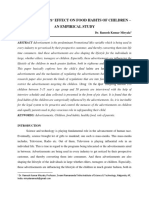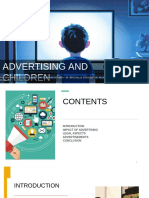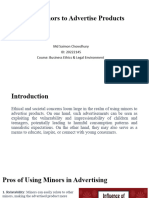Analyzing the Impact of Advertising on Children’s
Media Consumption
eurokidsindia.com/blog/analyzing-the-impact-of-advertising-on-childrens-media-consumption.php
By EuroKids August 21, 2023
As we navigate the digital age, there is an undeniable fact that children are heavily
exposed to a myriad of media channels. From television to the internet, our younger
generation is constantly consuming media in various forms. Consequently, this media
consumption is riddled with advertising content. Given their impressionable minds, the
impact of advertisement on children is profound and worth understanding. This article
aims to analyze this impact, with particular emphasis on its effects on children’s media
consumption and behavior.
The Impact of Advertisement on Children
Advertising has a powerful and lasting influence on children. Often designed with
persuasive intent, advertisements can shape a child’s understanding of societal norms,
influence their preferences, and, crucially, affect their consumption habits. Research
reveals that children are more susceptible to advertising due to their limited critical
thinking abilities. The impact of advertisement on children is therefore more pronounced,
with consequences ranging from increased media consumption to altered behavioral
patterns.
For instance, toy advertisements often compel children to ask their parents for the
promoted products. Similarly, ads for fast-food chains or sugary snacks can affect
children’s dietary choices. Hence, there’s an undeniable link between advertisement and
children’s media consumption behavior. However, it’s not just their consumption habits
that are impacted. Advertising also plays a role in forming children’s aspirations, values,
and self-image, essentially shaping their understanding of the world around them.
The Negative Impact of Advertising on Children
While advertising has its merits, there are undeniable negatives associated with it,
particularly when targeting children. Ads are crafted to make products and services seem
irresistible. Given children’s impressionable minds and limited ability to discern fact from
fiction, they often take these ads at face value. As a result, the negative impact of
advertising on children is considerable.
For example, consider the aggressive marketing strategies employed by the junk food
industry. The colorful, fun-filled advertisements often romanticize the consumption of
unhealthy food, leading to unhealthy eating habits among children. This is an alarming
consequence of the negative impact of advertising on children. Similarly, ads that foster a
materialistic worldview can lead to dissatisfaction and a constant desire for more goods
and services.
1/3
�Ads also tend to present stereotypical images, for example, gender stereotypes, which
may lead to children internalizing these harmful norms. Therefore, while advertisements
may foster consumer behavior, they may also inculcate negative behavioral patterns.
Mitigating the Negative Impact of Advertising on Children
While the negative impact of advertising on children is considerable, there are measures
that can be implemented to safeguard their interests. Parents, educators, and regulators
all have crucial roles to play in mitigating the negative effects of advertising.
For parents and educators, media literacy education is vital. By teaching children about
the intent behind advertising, we can empower them to critically evaluate the messages
they receive. For instance, explaining the commercial motivations behind ads can help
children understand that what they see is often an exaggerated depiction aimed at
promoting sales.
Moreover, parents can limit screen time and encourage children to engage in physical
activities, reading, and other non-media related hobbies. This can reduce their exposure
to advertising and promote a healthier, more balanced lifestyle.
The Role of Regulations
Regulations also have a significant role in mitigating the negative impact of advertising on
children. Many countries have guidelines in place that limit the nature and amount of
advertising aimed at children. For example, in Sweden, television advertising targeting
children under 12 is prohibited.
However, with the advent of the digital age, such regulations need to extend to online
platforms as well. The ever-growing presence of ads on social media, video games, and
streaming services is a pressing concern that needs regulatory attention. Ensuring that
such platforms have robust policies for age-appropriate content and advertising can
significantly minimize the negative impact on the younger generation.
Future Implications
As technology continues to advance, and as children’s media consumption habits evolve,
the relationship between advertising and children is likely to become even more complex.
It is crucial for all stakeholders to continue monitoring this space and take the necessary
steps to safeguard children’s interests.
The Impact of Advertising on Children’s Behaviour
Advertising has a potent influence on children’s behavior beyond their purchasing habits.
Repeated exposure to certain types of ads can mold children’s attitudes, perceptions and
actions. The impact of advertising on children’s behavior is multifaceted and extends to
various spheres of their life.
2/3
�For example, studies show a correlation between exposure to violent video game
advertisements and aggressive behavior in children. Another impact of advertising on
children’s behavior is observed in how they perceive themselves and others. For
instance, beauty and fashion ads often promote unrealistic beauty standards, leading to
body image issues among the younger generation.
The Impact of Advertisement on the Younger Generation
The younger generation, including teenagers, is also heavily influenced by advertising. As
they move towards independence, they become more active consumers, and
advertisements can significantly sway their choices.
The impact of advertisement on the younger generation can be witnessed in various
areas. One of the most evident impacts is on their lifestyle choices. Brands strategically
use popular celebrities and influencers to advertise their products, capitalizing on the
younger generation’s aspiration to emulate their idols. This has led to an increase in
demand for certain products, be it fashion, technology, or beauty products.
The use of social media for advertising has further intensified the impact. The younger
generation spends a significant portion of their time online, making them vulnerable to
targeted ads. These advertisements are often designed to encourage impulse buying,
leading to financial irresponsibility among teenagers.
Conclusion
In conclusion, the impact of advertisement on children and the younger generation is
multifaceted and pervasive. While advertisements can stimulate consumer behavior and
help businesses thrive, the negative impact of advertising on children cannot be
overlooked. It is crucial to educate children about the purpose and tactics of advertising,
empowering them to become informed consumers.
Regulations around advertising to children must also be strengthened, ensuring that
advertisers take responsibility for the content they produce. After all, advertisements
should not merely be a tool for profit but should also uphold ethical standards, ensuring
the wellbeing of the impressionable minds they influence.
EuroKids believes in nurturing a healthy learning environment for the kids, so if you’re
considering enrolling your child in a Preschool, consider EuroKids.
3/3




























































































